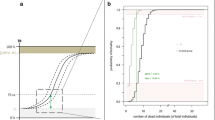Abstract
Daphnia magna is used widely as a standard ecotoxicological indicator organism, and protocols exist for its use in assessing the toxicity of substances under acute and chronic experimental conditions. Problems exist in repeatability of such bioassays between laboratories. Sources of variation are identified using a simple quantitative genetics model. Presenting specific examples, we conclude that these problems are tractable, but only if the genotype and culture conditions prior to and during tests are strictly controlled.
Similar content being viewed by others
References
Adema, D. M. M., 1978. Daphnia magna as a test animal in acute and chronic toxicity tests. Hydrobiol. 59: 125–134.
Berge, W. F. ten, 1978. Breeding Daphnia magna. Hydrobiol. 59: 121–123.
Cabridenc, R., dy1986. Exercice d'intercalibration concernant une méthode de determination de l'ecotoxicité à moyen terme des substances chimiques vis-à-vis des daphnies. Unpublished EC Report. Contract W/63/476 (214). Ref. I.R.C.H.A.D. 8523. Vert-le-Petit, France. 20 pp.
Falconer, D. S., 1981. Introduction to quantitative genetics. Longman. Harlow, Essex. 340 pp.
Goulden, C. E., R. M. Comotto, J. A. Hendrickson Jr., L. L. Horning & K. L. Johnson, 1982. Procedures and recommendations for the culture and use of Daphnia in bioassay studies. Pages 139–160 in Proceedings of the American Society for Testing and Materials Fifth Toxicology Symposium, Special Technical Publication Number 7668, Philadelphia, Pennsylvania, USA.
Hebert, P. D. N. & M. Beaton, 1986. Cellulose-acetate gel electrophoresis. Unpublished ms. Univ. Windsor, Ontario. 34 pp.
OECD., 1981. Daphnia sp. 14 day reproduction test (including acute immobilisation test). OECD guidelines for testing of Chemicals, no. 202. ISBN 92-64-1221-4. Paris. 15 pp.
Tessier, A. J., L. L. Henry, C. E. Goulden & M. W. Durand, 1983. Starvation in Daphnia: Energy reserves and reproductive allocation. Limnol. Oceanogr. 28: 667–676.
Author information
Authors and Affiliations
Rights and permissions
About this article
Cite this article
Baird, D.J., Barber, I., Bradley, M. et al. The Daphnia bioassay: a critique. Hydrobiologia 188, 403–406 (1989). https://doi.org/10.1007/BF00027806
Issue Date:
DOI: https://doi.org/10.1007/BF00027806




